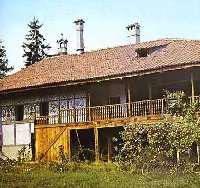|
|
| |
BULGARIA
BANSKO
One of the prettiest Pirin mountain towns, Bansko is situated at the foot of the Pirin Mountain and right below the Pirin National Park, a world national heritage site, although in recent years Bansko has also become known as a winter sports resort. Here the old lives hand in hand with the new, where the modern centre gives off onto small cobbled streets with timber framed houses sheltering behind stout double doors.
 Bansko's architectural heritage is best seen in master builder, woodcarver and painter Velin Ognyanov's work. He rebuilt the Sirleshtova House in the late 18th century and the Velyanova House around the turn of the 19th century.
Bansko offers a wide variety of choices like old-style pubs and taverns, restaurants, disco clubs and coffee shops in the old town. The Dedo Pene Tavern offers the delicious Bansko cuisine in a historical house built in 1820. In Milush Tavern you can try "chomlek", "Banski staretz", "sudjuk", kebap in pumpkin, "capama" and more.
From Bansko one can go to many interesting places. To Melnik and Rojen Monastery, to Sofia, Plovdiv and Bachkovski Monastery, to Sandanski and Velingrad, to Rila mountain (40 minutes by car) Borovets (20 minutes by helicopter) for a day skiing in another resort and Rila Monastery.
Surrounded by Pirin, Rila and Rhodopa mountains, Bansko is a climatic mountain resort with a short summer and long winter. The average temperature during january, the coldest month, is -1.9C. Snow falls are abudant, providing a constant winter snow cover up to 2 m thick. The skiing season along the Pirin slopes starts in the middle of December and ends in mid-April.
The skiing conditions in Bansko are excellent. The Pirin mountain has a predonantly Alpine charachter with three peaks towering above 2900 m. However the slopes offer runs and tracks for all types of skiers, from novice to the experts, while the ski runs are maintained in excellent condition.
 The two major ski regions of Bansko - the lower called Chalin Valog (1100-1600m) and the higher called Shiligarnika (1700-2500m) - are situated above the town, on the nothern slopes of Pirin mountain. Slalom and grand slalom runs are available in the Shiligarnika region. The third ski region is Banderishka Polyana.
The most suitable nursery slopes are around Motikata restaurant, a short distance from the town of Bansko. Nursery slopes are also available in the region of Chalin Valog and Shiligarnika. Bansko offers a cross-country track with a total lenght of 5 km. at a height of 1530 m above sea level at the Banderishka Polyana slope. A 3 km ski-run Rollbahn track is situated 2 km from the town at 1050 m above the sea level.
|
|
|
Festivals and Fairs
The Great Koprivshtitza Folklore Festival
The Great Koprivshtitza Folklore Festival is Bulgaria's largest gathering of traditional musicians and singers and is a cross between a pop festival and a medieval fair. It is a sight that knows no equal: thousands of musicians and singers making the hillside above the picturesque village of Koprivshtitza their home for a few days. Coupled with this you have the colourful stalls of the traders and the thousands of visitors who come for the festival.
This is Bulgarian music as it was always played, played by the ancestors of those who first played it. But perhaps it is what happens on the periphery that is the most authentic. Strolling players or soloists, simply playing for the sheer enjoyment. forming new bonds with other musicians or just letting their music ring out over the hillside.
The Bourgas International Folk Festival
The Bourgas International Folk Festival, held annually, attracts a host of Bulgarian and international artists and is held in the second half of August.
The Kazanluk Festival
The Kazanluk Festival of the Roses is held annually in early June, and has grown from a local to an international event. Not only are the roses, Kazanluk's main industry, in full flower. but the town itself blossoms while visitors enjoy the "Rose Picnic" and all the fun of a folklore festival, with its costumes, songs and dance. Should you still have the energy left, you can always visit the old factories where the rose oil is extracted.
St. Trifon's Day
In the agricultural calendar, St. Trifon's Day celebrates the pruning of the vines, and is held on February 14.
Kukerov Den
On the first Sunday before Lent, Kukerov Den celebrates the start of the agricultural year, and all over Bulgaria you can witness processions led by the dancing. leaping Kukeri dressed in colourful masks and costumes.
Baba Marta
Baba Marta is celebrated on March 1 when peasant house-holds brush out the winter cobwebs with a traditional spring clean. and people offer each other tokens of good luck called martenitsas.
Kukeri
Like western countries. the Bulgarian calendar is dotted with important feast days and festivals. The festival of the Kukeri re-enacts ancient surovaki rites to ward off evil spirits and Kukeri fertility rites. Although only held once every five years, it brings together dancers from all over Bulgaria in a rainbow of colours and styles.
St. Lazarus Day
Lazaruvane is also celebrated in spring on St. Lazarus Day, and here village girls considered fit for marriage perform ritual songs and dances.
St. Konstantin and St. Elena Day
The coming of summer is traditionally celebrated on St. Konstantin and St. Elena Day on May 21, and in some of the remoter villages in the Stranzha hills fire dancing, dancing on heated coals, is still practised in celebration of summer's arrival. Ethnologists have suggested that this practice is directly descended from Dionysina rites of the ancient Thracian.
|